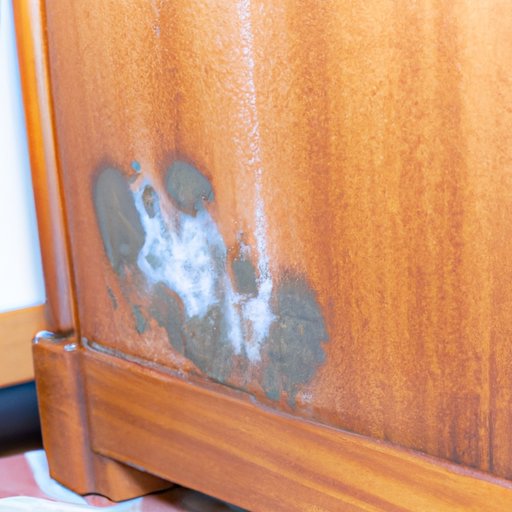Introduction
Mold growth on wood furniture is not only unsightly, but it can also pose a serious health risk to you and your family. In this article, we’ll discuss the potential health hazards of mold contamination, as well as how to identify and remove it from your wood furniture.

The Dangers of Mold Contamination in Your Home
Mold spores are naturally present in the air both indoors and outdoors, but when they land on wet or damp surfaces such as wood furniture, they can quickly multiply and spread. This can lead to mold contamination in your home, which can have serious health consequences for those living there.
The most common health effects of mold exposure include respiratory problems, allergic reactions, skin irritation, and eye irritation. In some cases, more severe reactions such as fever and difficulty breathing have been reported. People with weakened immune systems, such as infants, elderly people, and those with chronic illnesses, are particularly vulnerable to the health risks posed by mold.
In addition to the health risks, mold can also cause structural damage to your home. As it grows, it can weaken the structure of the wood, leading to warping, cracking, and discoloration. This can reduce the value of your furniture, as well as make it less safe to use.

How to Identify and Remove Mold from Wood Furniture
If you suspect that your wood furniture may be contaminated with mold, there are several steps you can take to identify and remove it. The first step is to look closely at the surface of the furniture for signs of mold growth, such as dark spots or discoloration. You may also notice a musty smell, which is a sign of mold growth.
Once you’ve identified the affected areas, the next step is to remove the mold. This can be done using a combination of scrubbing, vacuuming, and chemical cleaning agents. If the mold is severe, it may be necessary to replace the affected piece of furniture altogether.

Protecting Your Family from the Hazards of Mold on Wood Furniture
The best way to protect your family from the dangers of mold on wood furniture is to take preventative measures. Make sure to keep your furniture dry and free from moisture, as this will inhibit mold growth. Additionally, inspect your furniture regularly for signs of mold, and address any issues immediately.
If you live in an area with high humidity levels, consider investing in a dehumidifier. This device will help keep the air in your home dry and free from excess moisture, making it inhospitable for mold growth.
What to Do if You Find Mold on Your Wood Furniture
If you do find mold on your wood furniture, the first step is to clean and disinfect the affected areas. Use a mild detergent and warm water to scrub away the mold, then rinse the area with clean water. You may also want to use a commercial mold remover to ensure that all traces of the mold are gone.
In some cases, the mold contamination may be too severe to handle on your own. If this is the case, it’s best to call in a professional to assess the situation and provide a course of action. They may recommend replacing the affected furniture, or treating the area with a specialized mold removal product.
Conclusion
Mold on wood furniture can be a serious health risk to you and your family. It’s important to be aware of the potential health effects of mold contamination, as well as how to identify and remove it from your furniture. Taking steps to keep your furniture dry and free from moisture, as well as regular inspections, can help protect your family from the hazards of mold.
If you do find mold on your wood furniture, it’s important to act quickly to remove it. Cleaning and disinfecting the affected areas, as well as seeking professional help for severe cases, can help ensure that the mold is gone for good.


